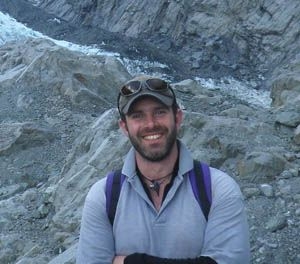Dr Tristram Irvine-Fynn
PhD in Geography – Glaciology (University of Sheffield, UK, 2008) MSc in Geography – Glaciology (University of Calgary, Canada, 2004) BA in Geography (University of Cambridge, UK, 2001)

Reader
Department of Geography and Earth Sciences
Contact Details
- Email: tdi@aber.ac.uk
- ORCID: 0000-0003-3157-6646
- Office: J12, Llandinam Building
- Phone: +44 (0) 1970 622784
- Research Portal Profile
Profile
Tris initially joined DGES in Feb 2011 as a process glaciologist Research Fellow employed through the C3W initiative. With earlier experience on temperate alpine glaciers, Tris started researching High-Arctic glaciology on Svalbard in 2000. Supported by a Canadian Memorial Foundation Scholarship, he worked on utilising ground penetrating radar (GPR) to delineate hydrological connections and changes within Stagnation Glacier, Bylot Island, Canadian Arctic; this project yielded an MSc from University of Calgary which was awarded the Chancellors Medal. Subsequently, he returned to the University of Sheffield for his PhD research: a detailed hydrological study of Midtre Lov?nbreen, Svalbard. Tris was then employed at Sheffield - funded by The Leverhulme Trust as a PDRA and NERC as a Research Co-Investigator - focusing on projects exploring the "greening of retreating arctic glaciers" in collaboration with the University of Bristol. This area of research has continued in Tris' tenure of the C3W Fellowship, with focus on novel techniques to monitor supraglacial characteristics and processes and close collaboration with colleagues in IBERS. In particular, his interests include the hydraulics of near-surface ice, the seasonal development of ice surface roughness and albedo, and feedbacks linked to the important ecological niche that glacier surfaces represent. Throughout his research career Tris has contributed to teaching across a wide range of physical geography courses, including ones based at UNIS (Svalbard).
Teaching
Module Coordinator
- GS31030 - Pollution in the Arctic (UNIS)
- GS23510 - The Frozen Planet
- GS32230 - Arctic Hydrology and Climate Change (UNIS)
- GS32330 - The Quaternary History of Svalbard (UNIS)
- GS32430 - Arctic Marine Geology (UNIS)
- GS33420 - Glaciers and Ice Sheets
Lecturer
- GS34220 - Geography Joint Honours/Major Project
- GS21120 - Physical Geography and Environmental Science Research Design and Fieldwork Skills
- DA25420 - Dylunio Ymchwil a Sgiliau Gwaith Maes
- GSS0260 - Work Placement
- GS20020 - Geography Research Design and Fieldwork Skills
- GS21420 - Environmental Earth Science Research Design and Fieldwork Skills
- DA34040 - Traethawd Estynedig Daearyddiaeth
- DA34220 - Prosiect Daearyddiaeth Anrhydedd Cyfun/Prif Bwnc
- EAM1120 - Advanced Research Skills 1: science communication and data analysis
- GS35140 - Environmental Earth Science Dissertation
- GS11520 - How to Build a Planet
- GSS0360 - Work Placement
- GS34040 - Geography Dissertation
- GS13020 - Researching the World: data collection and analysis
- GS35240 - Environmental Science Dissertation
- PGM2310 - Research Skills and Personal Development (Science) (2310)
Coordinator
- GS32430 - Arctic Marine Geology (UNIS)
- GS23510 - The Frozen Planet
- GS33420 - Glaciers and Ice Sheets
- GS32230 - Arctic Hydrology and Climate Change (UNIS)
- GS32330 - The Quaternary History of Svalbard (UNIS)
- GS31030 - Pollution in the Arctic (UNIS)
Course Viewer
Research
Group Affiliation
- Centre for Glaciology (CfG)
- Interdisciplinary Centre for Environmental Microbiology (iCEM)
- Climate Change Consortium of Wales (C3W)
Research Interests
Tris' research interests are focussed on process glaciology and hydrology, particularly in the High-Arctic:
- Glacier thermal regime and hydrology
- Supraglacial processes and ecology
- Method development for process glaciology
- Paraglacial dynamics in arctic catchments
